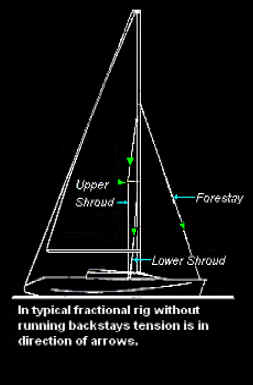|
A good starting point is to begin the tuning process with the premise that the permanent backstay has little or nothing to do with forestay tension. This obviously goes against the grain for any sailor accustomed to a masthead rig, but it is the single most important concept in tuning this type of rig. A fractional rig is really nothing, more than an exercise in triangulation. Forestay tension is transmitted directly to the upper shrouds which, via the spreaders, push the mast forward. The lower shrouds in turn pull the middle of the mast aft, acting against the forward thrust of the upper shrouds and spreaders and keeping the mast in column ( see fig. right). However, because the angle between the forestay and the upper shrouds is small in comparison to the angle between the forestay and backstay on a masthead rig, it is necessary to carry considerably greater rig tension in a fractional rig to achieve a comparably straight forestay.
|
 |
Setting up a rig of this nature is really quite simple once the principle is understood:
1. Set up the mast and shrouds so that the mast is straight and raked as desired
2. Tighten the upper shrouds symmetrically until the tension induces the beginnings of an athwartships compression bend in the spar. Back off each turnbuckle one half turn.
3. The upper shroud tension will have induced a fore-and-aft bend in the spar because of the pressure transmitted to the spreaders. Reduce this by tightening each lower shroud symmetrically until either the mast is straight or until you’ve achieved about three-quarters the mast bend your mainsail was cut for.
4. Shackle the jib halyard to the tack fitting and wind it down until it is as tight as you would ever want luff tension. Then take up the slack in the forestay being careful not to gall the turnbuckle but tightening it down hard.
5. Now, tighten the backstay. It should only be able to deflect the uppermost section of the spar above the forestay and the bend should disappear below the jibstay. If tightening the backstay increases mast bend at the spreaders, the lower shrouds are too loose and their sag will wind up in the forestay when the first puff hits.
6. Finally, release the jib halyard and backstay and check the shroud tension. The uppers should just be slightly tighter than the lowers to accommodate their greater stretch.
7. When you sail hard on the wind, verify that neither the leeward upper nor lower go slack and check the mast shape.
8. Because proper tuning means that the mast has little or no fore-and-aft bend, the mainsail should be designed for a much straighter mast than many sailmakers have assumed. Any bend induced by backstay tension thus merely frees the leech without otherwise affecting the mainsail below the intersection of the forestay. The mainmast should remain straight and be free of athwartships bend. The backstay can be reserved for its primary function in life - mainsail leech control.
9. Always remember to ease off the forestay before leaving the boat because this rig puts a tremendous bending moment on the hull.
If you are racing in a handicap fleet the results of a properly tuned rig may not be all that obvious unless you have a very close boat-for-boat competition. In a one-design fleet, the results to weather will be convincing.